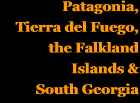Coalfields in the far south, and proposed railways
Whilst it is the Rio Turbio coalmines that most foreign railway enthusiasts will have heard of, in fact there are a wide range of coal deposits stretching down through Patagonia across a long belt of country. Most of those worth exploiting are in or near the Chilean province of Magallanes, but a number of small mines have been operated for short periods elsewhere.
The various small pits in the Argentine provinces of Neuquen, Rio Negro, Chubut and Santa Cruz are considered first, and then the more productive area further south.
Mines throughout Argentine Patagonia
Nowadays it is easy to be unaware of any Patagonian coal mines other than those at Rio Turbio. However, a technical paper produced in 1956 lists over 100 locations where coal or lignite can be found between Neuquen and Rio Turbio (1). At least ten of these have been worked at some point, often reaching a peak during either world war when Argentina was very short of fuel. From north to south these are listed below:
A Neuquen province
Mina Cristina South of Zapala at the end of the FC Sud's Neuquen line.
Mina Burgos Very close south west of the previous site
Mina Jorge Newbery, north of Lago Nahuel Huapi near Nirihuau station. Privately owned. Worked from 1901. Production 2165 tonnes in 1944.
The Neuquen area contains deposits of asphaltite. This mineral is a more or less solid form of bitumen, with a hydro-carbon base but requiring to be mined in the same way as coal rather than drilled for like oil. The following photos show the asphaltite mine at Tacquimilan, which was exploited during the 1940s (12).
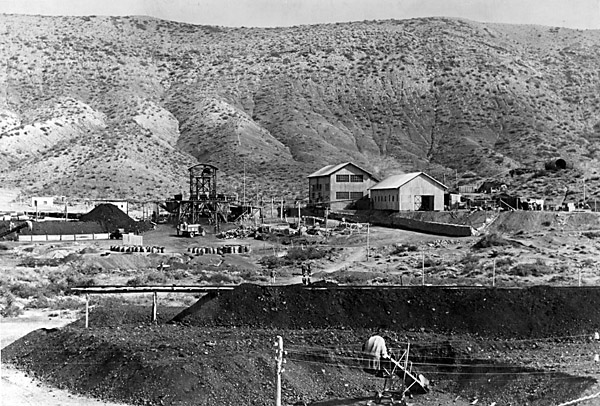
First a general view of the mine, taken in 1943. The shaft head-gear is left of the large buildings. left of that is a stockpile, and in the foreground another. Below is a close-up, showing the small tipper wagons which brought the product out of the mine.
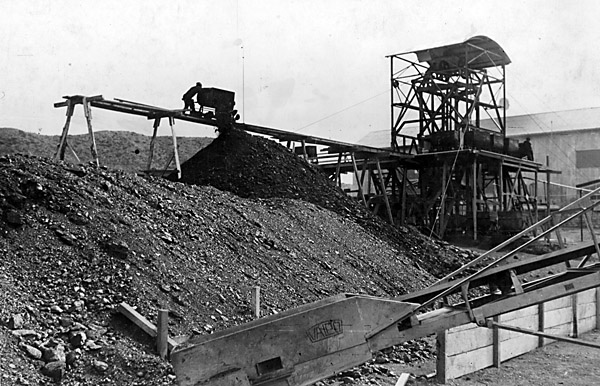
B Rio Negro province
Mina San Medardo Privately owned.
Mina Pico Quemado North west of Norquinco on the Esquel line. This was a big operation, with several different parts, namely Minas Quimey Mamil ll, Quimey Mamil lll, Loeuf Mamil, Santa Barbara, Santa Isabel, Gerardo, and María Luisa. The whole operation was owned by the Cia. Minera e Industrial de Rio Negro SRL. To give an indication of size the Mina Quimey Mamil ll employed 123 workers in 1952.
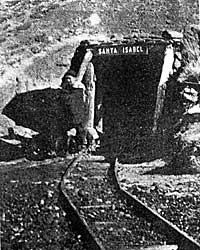
A photo in the above-mentioned 1956 report shows an end tipping wagon being pushed out of the Santa Isabel adit by hand on tracks which might well have been of 60cm gauge.
C Chubut province
Mina Indio, near Cushamen east of El Maiten Worked by the Cia. Minera Chubut, by the Cia. Minera Electra SA, and later by the YCF.
Mina Lepa, near Lepa station. The Henschel 0-6-0T at El Maiten was converted for a while to use this coal rather than oil fuel.
Mina Santa Ana, near Cholila
Mina San Pedro, north west of Esquel.
Mina General José de San Martín - Epuyen. This was worked for a while by the FFCC del Estado in 1917-8, presumably to see if it could economically produce suitable loco fuel. 500 tonnes was extracted for trial purposes.
D Santa Cruz province
Mina Cabo Curioso, on the coast north of Puerto San Julian. The trial levels were just about at sea level, with short upshafts to bring the workings out between the beach and the cliff above. 250 tonnes was brought out in 1945-6. The beach is known to this day by its earlier role as the site of a mine.
Mina La Criolla
The map below shows the location of these mines.
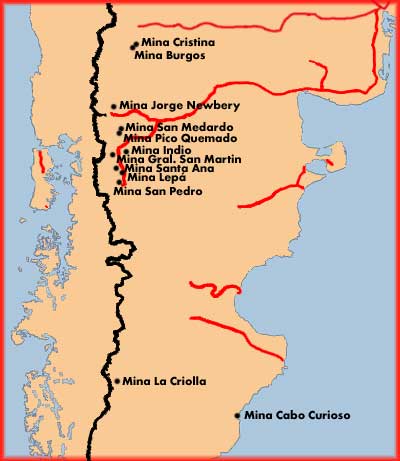
Coal down around the straits
To many the Straits of Magellan will seem too far from heavy industry to be worth the shipping costs, but until 1914 of course, much of the world's shipping passed the area on its way round the Horn to the west coast of the Americas. In those days a good big coalfield down in Magallanes would have been worth a great deal. Punta Arenas or Rio Gallegos could have become major bunkering ports.
From the Sierra Baguales north of the Torres del Paine, down to the Admiralty Sound in Tierra del Fuego, explorers have come across seams of coal and have attempted to exploit them. Frequently their plans have involved the construction of railways to ship the coal out. In most cases nothing much happened, principally because the coal was of poor quality or in thin seams expensive to work.
The map below shows the location of the main southern deposits (2). The numbers relate to the mines listed further down the page.
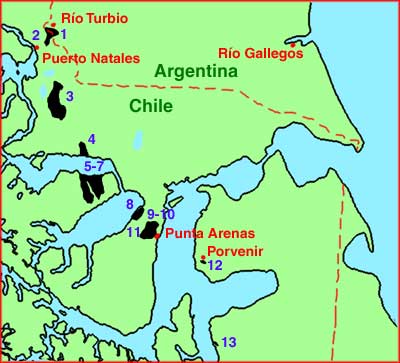
The individual mining areas
The Sierra Baguales
Even further north than no. 1 on the map above was the Sierra Baguales, beyond what is now the Torres del Paine national park. Around 1925 Enrique Rothenburg proposed the exploitation of the coal deposits of the area. However, the distance from possible customers deterred any action. A railway had been proposed to carry the coal south to Puerto Natales and eventually to Punta Arenas. Some time later Ernesto Písano and Carlos Fischer revisited the proposal but again without result.
Mina Tres Pasos
Around 1940 there was some interest in opening up a mine near the Rio Tres Pasos, 25 miles north of Puerto Natales, but nothing came of it.
1 The mines of Rio Turbio
Discovered by Agustin de Castillo in 1887, but not worked seriously until 1943 because of difficulty of getting the coal out without going into Chilean territory. These mines and their railway take up a large part of this chapter.
2 Minas Natales and Dorotea in the Sierra Dorotea
Just over the hill from the big Río Turbio mines was the Mina Natales, worked from 1937 to supply the frigorificos of Puerto Bories and Puerto Natales. Production reached 5792 tonnes in 1943 but seems to have declined thereafter. In the same area a Mina Dorotea is apparently still worked on a very small scale, by about three men.
3 Lakes Balmaceda and Diana
I don't know whether these deposits have ever been worked.
4 Mina Rica/Mina Marta
The first discoverer of coal in the Rio Verde area, Santiago Zamora, named the deposit Mina Rica (rich mine). It will be clear from this that the word 'mina' has been used generally to refer to a workable coal seam or seams (a 'yacimiento' more commonly in Spanish) as well as specifically to a working mine. Coal deposits in this area may possibly have been worked by the Tehuelche indians even before the arrival of Europeans (3).
A year or two later Dr. Julius/Julio Haase hoped to work these deposits in the late 1870s but ran out of funds after starting work. He had renamed the outcrop Mina Marta, and had gone so far as to erect buildings and open up at least six adits, with pumps to keep them dry. A 50m wooden muelle had also been constructed. In 1880 a company, Somoza Míro y Cía, was floated in Buenos Aires to restart work in the mine, but despite the extra investment but the coal was not of sufficient quality to be profitable so far from the market of Punta Arenas. The coal was described again in 1897 (2) as being of poor calorific value. There were three seams of respectable thickness (1.5 to 2m.) worked by the bord and pillar method. Detailed descriptions of visits to this mine exist () ().
5 Mina Magdelena, Isla Riesco
This was on the north side of Riesco island, facing the Skyring sound. The main seam was almost horizontal and outcropped along the coast at sea level. A Frenchman, Señor Jorge Méric, had discovered the site in 1889 and by 1897 he and the Braun y Blanchard trading house in Punta Arenas were working the mine and transporting the coal to Punta Arenas in the steamer 'Torino'. The coal had been the subject of a detailed cost analysis in 1897, comparing it with Cardiff coal (2). However, the mine closed in 1900 owing to its lack of profitability (10).
6 Mina Elena, Isla Riesco
Also on the north coast of Isla Riesco. The Norwegian Ove Larsen Gude discovered new coal seams close to where the Mina Magdalena had been. The Comunidad Minas de Carbón de Río Verde was formed in 1922. Production had built up to 2000 tons per month by the 1930s and continued at least until the 1940s. The mine certainly possessed narrow gauge track with four wheeled tippers but as the adit entrances opened directly onto the shore by the jetty locomotives may not have been necessary. The photo below shows the substantial central structure including sloping rail tracks up which wagons were winched from the inclined adits before the coal was tipped and sorted. There is a description of a visit to this mine in Hakon Mielche's book Journey to the World's End published in 1939 (4). Señor Martinic (11) comments that there was a steam winch and pump, a steam sawmill, and a muelle eventually extending out to give 25 feet of depth at low water. The equipment could load 20 tonnes per hour into vessels at the muelle, and eventually a 1000 bunker permitted the loading of 500 tonnes per day. Other buildings housed workshops, warehouses, a school and everything necessary for a population which passed the 400 mark by 1940. Production reach a peak of 100,000 tonnes in 194?, helped by the superior quality of the coal. Closure came around 1952.
The photo below of the Mina Elena on Isla Riesco comes from Duncan Campbell's 'Patbrit' website.
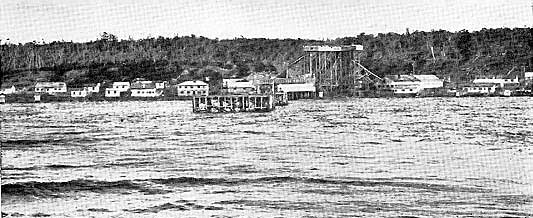
A second photo from the PatBrit site shows what a large complex the Mina Elena site had become by the mid 1940s.
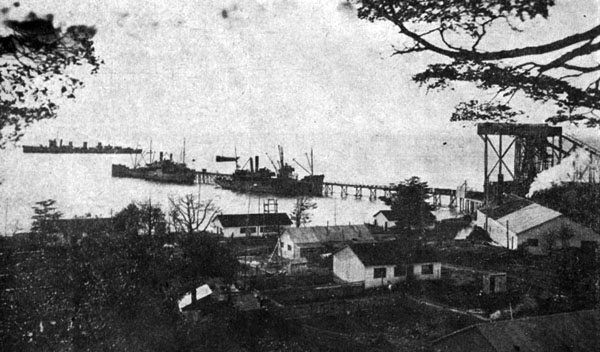
The next picture, kindly provided by Carlos Gonzalez Macaya who has studied the history of the Fisher family of Magallanes, through the good offices of Duncan Campbell, shows more details of the high level coal screens and shoots that were central in the picture above.
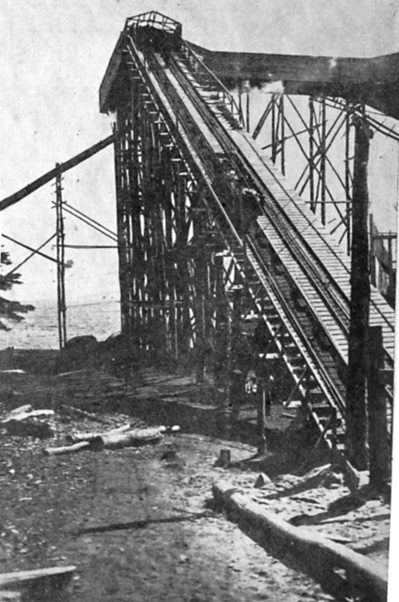
7 Mina Chilenita, Mina Kusanovic or Tres Hermanos, and Mina Josefina
A detailed geological map of this location (5) shows two mines immediately to the east along the shore – Mina Chilenita and Mina Kusanovic. Mina Chilenita operated from 1924 to about 1940 under the management of Jorge Ihnen and Fransisco Cekalovic. Mina Kusanovic or Tres Hermanos was on the site of the old Mina Magdalena and was begun by the Kusanovic brothers of Punta Arenas. Production was small (only a few hundred tonnes per year in the early 1940s) and short-lived. Towards the end the mine was taken over by the Sociedad Carbonífera Josefina who began a new Mina Josefina nearby. This was more productive, rising to a peak of 11,000 tonnes in 1943. Production seems to have continued until 1952 (10).
Isla Riesco may yet see more coal extraction, for the Estancia Invierno towards the eastern end of the island has large deposits of commercially viable coal.
8 Mina Peckett
On the east (mainland) side of Canal Fitzroy, north west of Punta Arenas, the Sociedad Ganadera y Comercial sara Braun owned the Estancia Peckett Harbour and opened up a source of relatively high quality coal within their boundaries. Production started around 1939 at 400 tonnes, but had risen to 1793 tonnes by 1943. The mine was worked with relatively modern equipment until 1970. The site has recently been opened up as a huge open-cast pit (strip mine). Enormous dumper trucks transfer the coal to a nearby jetty from where it is shipped north to Chile's copper smelters in 65,000 ton bulk carriers. In the circumstances, there are not likely to be many signs of old railway tracks!
9 Mina Tres Puentes
South east of Mina Pecket. The Sociedad Ganadera Bitsch Hermanos obtained a concession in 1936 on land which they farmed, and opened the Mina Tres Puentes which reached a respectable size after being leased to a purpose-made consortium. Production was 7223 tonnes in 1939 and had risen to 33,731 tonnes during 1943 when of course demand was considerable in the absence of British supplies. The mine eventually closed in 1950.
10 Mina Vulcano
North of Punta Arenas. This was taken over by Messrs. Pacheco and Harambour in 1943 who introduced mechanical assistance including a steam shovel to raise output from the 1876 tonnes of 1940 to 11,897 in 1943. This mine finally closed in 1957. A Mina Salvadora worked for a short while slightly further north in the 1950s.
In the same area the Mina Fernández Rocuant operated on a small scale around the end of the 1930s.
The Mina Vulcano excavator is now preserved in the Museo del Recuerdo near Tres Puentes on the main road north out of Punta Arenas.
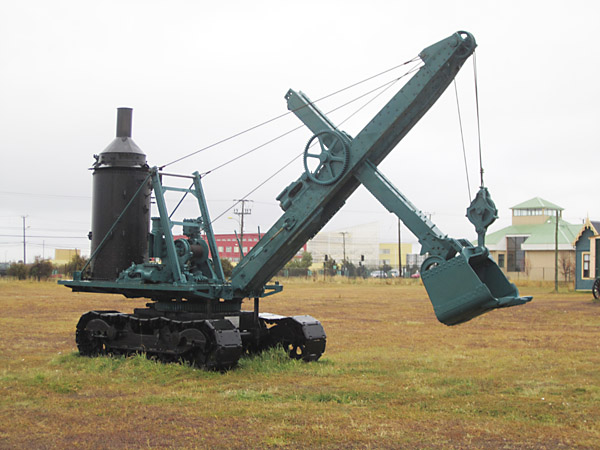
11 Mina Loreto, and other mines in the Río de las Minas
From the hills immediately behind Punta Arenas runs the 'River of the Mines'. This has cut a deep valley into the sediments of the hills, which has given access to the various coal seams. Its proximity to the town and port of Punta Arenas led not only to the exploitation of the Mina Loreto over one hundred and fifty years or more but also to the construction of a railway. This has its own pages.
Other mines have been worked within the same valley, or nearby, though none had such an illustrious history as the Loreto site.
• Juan Cañón and José and Evaristo Andía were working the Mina Soledad in 1919 on both banks of the river some way to the west of Mina Loreto. The concession was sold to Messrs. Molinare, Cevallos and Olivares soon afterwards, but their plans to exploit the mine on a much bigger scale seem to have come to nothing. Mateo Martinic B. in his comprehensive 2003 paper () suggests that the need to gain access across Menendez Behety lands and to use their Mina Loreto railway may have squashed the idea.
• To the south of the valley the Mina Chino began operations in 1930 with a 4km Bleichert cableway, and was producing around 2,500 tonnes of house coal per year by 1940. Associated with this operation by then were other concessions 'Dos Amigos 1 & 2' but whether these were ever worked is unknown. The main mine unfortunately ceased operation in 1941 after a fire destroyed the surface facilities. In the same area south west of Punta Arenas another mine, Mina Chinita 1, 2 & 3, worked on a very small scale for twenty years or so, including 1943 when it produced 1,200 tonnes, but was abandoned after flooding of the workings in the winter of 1958.
• North of the Rio de las Minas Mina Punta Arenas produced 2,000 tonnes or more per year during the years of the Second World War, whilst Mina Servidora produced a probable peak output of 600 tonnes in 1940. A Mina Estela also opened after the war in 1946.
Even today many of these deposits are still being worked. In most cases such mines are very small scale indeed, being real 'two men and a dog' outfits. The photos below are of one such mine, discovered by accident whilst looking for Mina Loreto. Mateo Martinic's paper refers to recent operations of Mina Arauco, Mina Soledad (not the one mentioned above), Mina El Bosque, and a Mina Santa Rosa put into operation in 1960. This last was explored by Wilfred Simms, who investigated railways in the Rio de las Minas area in 1978 and 1987 (7). He reported that it had approx approx. 18 inch gauge tub lines using man haulage. He also found the Mina Loreto Segunda, also using 18 inch gauge but with winch haulage.
In the hills behind Punta Arenas one can still stumble across small private pits such as the one shown in the two pictures here. This one is a mile or two southwest of Mina Loreto. There were signs of other workings in the area too.
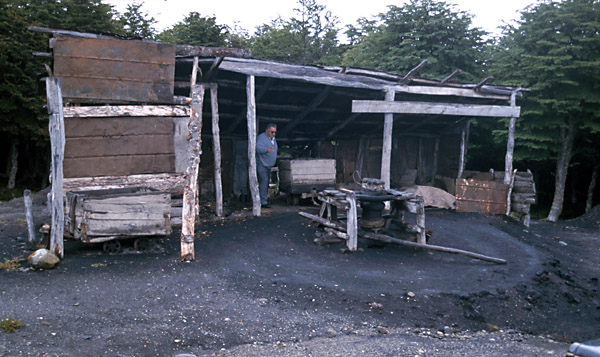
The top picture shows the 'headgear', of the inclined shaft - merely a wooden capstan to winch up the two wooden wagons visible here. One is on the left whilst in the centre is one which has just been hauled out.
Below, looking down beyond the full wagon, is the shaft. No sign here of electric winders, ventilation fans, coal washery, or even of pithead baths! The two workers have a small hut nearby.
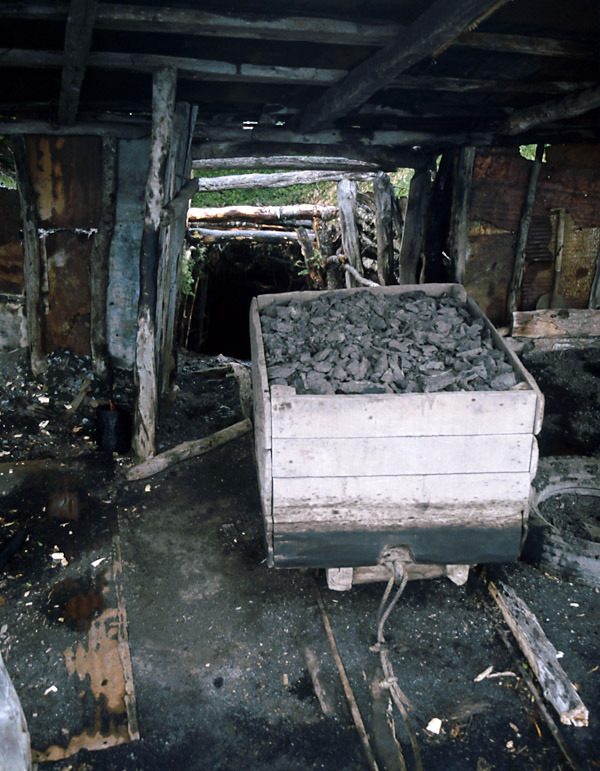
12 Mina Santa Clara
Near Porvenir. Nothing known about this. Possibly at the mouth of the rio del Oro.
13 Mina Arturo Prat
Coal was discovered in the Nose Peak area of Admiralty Sound in 1887 by Cosme Spiro. In 1895 he formed the Soc. Carbonifera de Tierra del Fuego. A mine was opened at Puerto Sofia (aka Pto. Condor) between Pto. Arturo and Pto. Yartou but it did not last long. The coal was reputedly of better quality than that in the Rio de las Minas, but the extra transport costs killed its chances.
Coal bearing strata were apparent at other places in Chilean Tierra del Fuego, such as the mouth of the Rio Santa Maria in Useless Bay, and on the Rio Oscar and the Rio del Oro. On Isla Hoste south of the Beagle Channel coal had also been found in Tekenika Bay. Far on the other side of the border Bahia Sloggett faces south onto the Beagle Channel well east beyond Harberton. Coal deposits here on the left bank of the Rio Lucio Lopez towards Barranca Blanca were explored but never worked commercially (6).
Many locations about which nothing is known, may have been worked on a small scale and at various times. The various steam-powered gold dredges introduced into Tierra del Fuego around 1906 during the short-lived gold rush may well have been run on locally extracted coals. When coal was in short supply during the Second World War production in Isla Riesco and Peninsula Brunswick is reported to have gone up from 66,000 tons to 162,000 tons. The number of mines worked similarly rose from eight to twelve, with 700 miners at the peak. Finally, M. Martinic cites the records of The Conservador de Minas de Magallanes which contain the following names of unidentified mines: Mina Francisca, Mina Julio, Mina Margarita, Mina Isabel, Mina Juana, Mina Mercedes, Mina Nalona 1-3, Mina Irmita, Mia Raquelita, Mina María somewhere in Tierra del Fuego, Mina Robertina, Mina Purisima, Mina Silvia, Mina Zulema, Mina Talcahuano, and Mina Loreto 1-29 (obviously not the well-known mine of that name).
Proposed railways
There have been a number of railways proposed in the very far south, for the hauling of coal out to the main seaports amongst other things. Whilst only two of them were ever built, the others remain of interest. The map shows where they would have run, and each proposal is described below. I am indebted to Mateo Martinic's book Patagonia de Ayer y de Hoy (9) for much of this information.
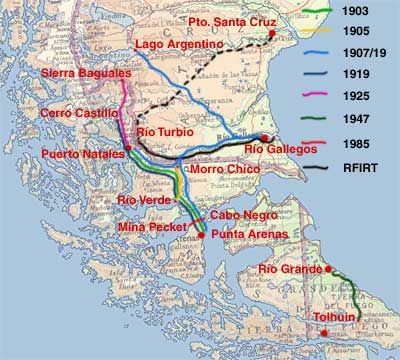
The individual proposals
1869 A tramway was constructed out of Punta Arenas, up the bank of the Rio de las Minas to aid in the movement of coal from the valley sides further upstream. This was later relayed as a metre gauge loco-worked railway and extended to the Mina Loreto. This line has its own pages in this chapter.
1903 'The Comisión de Alcaldes' considered building a railway from Punta Arenas to the Ultima Esperanza area around Puerto Natales. At this time there was a lot of interest in the development of Ultima Esperanza.
1905 A line from Morro Chico down to the coast of the Seño Skyring at Rio Verde was suggested in connection with gold mining speculation.
1907 Pyneiro, Sorondo y Cia. proposed opening up Argentina's Santa Cruz province by building a railway from Rio Gallegos to Lago Argentino. In 1911 The Review of the River Plate reported that a bill granting a concession to one Norberto Cobos had been approved. The line was to be of 75cm gauge from 'Puerto' Gallegos to Lago Argentino with four branches (8). Nothing came of this but the idea was revived in 1919 by Mauricio Braun and Alejandro(?) Cobos who also suggested branches to run to Punta Arenas and Puerto Natales.
1919 The last proposal frightened the businesses of Punta Arenas, who counter-attacked with a proposed railway from that port up to the Ultima Esperanza area. This would have run via Cabeza del Mar, Laguna Blanca, Morro Chico, Chorillo de los Alambres, Llanuras de Diana, between lakes Balmaceda and Diana, to Puerto Natales and on to Cerro Castillo. Mateo Martinic (9) suggests that a formal survey was made as far as Cabeza del Mar, but that the 'Captains' of the great Punta Arenas business houses disliked the proposed route along the coast, considering it too vulnerable in time of war. He also comments that the idea of a railway up to Puerto Natales was raised again for the last time in 1940, but 'sin eco publico'.
1925 Señor Enrique Rothenburg, the holder of the mining rights up in the Sierra Baguales northeast of the Torres del Paine, proposed a railway from there to Puerto Natales to get the coal deposits out.
1947 A timber and farming railway was to be built in Tierra del Fuego, from Tolhuin in the forests at the east end of Lago Fagnano, to Rio Grande on the coast. Apparently some of the 75cm. gauge material from Puerto Madryn was brought down ready for this before the proposal was scrapped in favour of the next scheme.
1950 The Argentinean government, having determined to get the coal out of the Rio Turbio area by some means or other, had first considered a line north-east to Santa Cruz. However, a shorter route eastwards to a new port at Rio Gallegos was chosen. Out of all the railways listed here this was the only major one to be built. It still runs today, albeit to an even newer port, Punta Loyola, south east of Rio Gallegos. This railway is considered in some detail later in this chapter.
1985 The recent development of the Mina Pecket north west of Punta Arenas, as a big opencast pit, led to calls for a railway to be built to take coal east to Cabo Negro where the existing petro-chemical plant could use the raw material. I do not know how seriously this was suggested.
References
1 Recursos Minerales de la Rep. Argentina, Vol lll Combustibles Solidos Minerales. 1956 Angel V. Borrello. Imprenta y Casa Editiones 'Coni', Buenos Aires.
2 En el Territorio de Magallanes - Tomo 1. 1897. Don Mariano Guerrero Bascuñan. Ministro de Colonización, Santiago.
3 Darling of Sandy Point, a children's book by Bessie Marchant who wrote a large number of girls' adventure stories set in wild parts of the world; her background knowledge of the areas she used was normally fairly accurate. Published by the Christian Knowledge Society, London, 1907. Another of her tales (Greta's Domain) mentions the Chiloé Island railway, but just in passing, with no details given.
4 Journey to the World's End, Hakon Mielche, first published in Danish, translated into English and published by William Hodge & Co, London. 1939.
5 Geografica Económica de Chile, volumes 1-3 + appendices. 1950-66. Corporación de Fomento de la Producción, Fundación 'Pedro Aguirre Cerda'. Santiago.
6 Information from David Guevara of Rio Grande.
7 The Railways of Chile, Volume 5 - Southern Chile. 2002. Wilfred Simms. p68.
8 Report in Review of the River Plate, issue 22nd September 1911 page 757.
9 Patagonia de Ayer y de Hoy. 1980. Mateo Martinic B. Ediciones Soc. Difusora Patagonia Ltda., Punta Arenas.
10 Río Verde, su historia y su gente. 2002. Mateo Martinic Beros. Rio Verde town council.
11La Minería del Carbón en Magallanes entre 1868-2003. Mateo Martinic Beros. 2004. Instituto de Historia, Pontifica Universidad Católica de Chile, Historia No 37, Vol. 1.
8-8-11
|

